Donna, the “freak” hurricane, swept the Vineyard on Monday, bringing winds of varying velocity, some hard rain-squalls, and spreading miner disaster. Miner, as to individual examples although the list of damage seemed endless. A few boats ashore, literally hundreds of trees split, twisted off and in a few cases, uprooted, and paralysis of the Island’s electrical system for hours, but not crippling the telephone system as badly.
Tides ran high, and a large number of waterfront properties in various parts of the Island suffered battering by floating debris. Yet, the concensus, gathered the Island over, was that the Vineyard got off easily and with far less damage than it has suffered in previous hurricanes.
Living up to its reputation, Donna was as freakish over the Island as elsewhere. The wind appeared to travel in streaks, twisting off trees by the roadsides and far into stands of wood where the riven trunks and shattered boughs could be seen. Yet a short distance away there was no apparent damage at all.
Velocities 60 to 85 Miles Reported
This circumstance, if true, might account for the different opinions on the wind velocity, and the variation in readings. At the height of the storm, readings in Edgartown were 80 miles. The Gay Head Coast Guard estimated 70 and the Northest Airlines anemometer registered 60 knots or 69 miles. At about the same time Cuttyhunk Coast Guard Station reported a reading of 62, and shortly before, a reading radioed from Brenton’s Reef Lightship, read 82. Stephen C. Gentle reported a record of 85 when his anemometer was blown out of commission, and guessed at a 100 mile peak.
It was a fact that ample warning was given of the approach of the storm. All had opportunity to secure property, if such a thing was possible, and to leave areas that might become dangerous. People had been notified to evacuate low areas, and presumably had done so. But the information carried on the air was contradictory and highly misleading at times, and this did not help.
The terrifically high tides predicted did not materialize. Compared with the last hurricane to strike the Island the tide level was-below the height brought in by that storm. No damage resulted on the Dutcher Dock at Menemsha Creek, for example, which mole was a litter of wreckage and stove boats in the last storm. Everett Poole, whose store and service station is located on the mole said: “If the tide had come a foot higher everything would have gone. As it was, nothing fetched away.”
The largest number of boats in trouble exclusive of rowboats, was probably in Menemsha Pond where both pleasure and commercial craft had gone for shelter. Laying to anchors for the most part, several were swept ashore, but it was not apparent that serious damage occurred to any of them.
Skeletal Frameworks Stood
Freakiness was observed as regards radio and TV antennae, few of which were affected. With tree-limbs blown ‘away in all directions, these skeletal frameworks stood up for the most part.
In Vineyard Haven the metal roof was wrenched from the town garage, and from the fact that sections of corrugated iron were found more than a mile away, it is believed that fragments of the roof accounted for them. The guest house, located on the Lagoon Pond shore at the recently purchased home of Robert M. Love, partially collapsed before the forces of wind and water and .Mr. and Mrs. Robert H. Hughes of Oak Bluffs, who were occupying the place, were obliged to leave.
Although the sea washed over highways in various places Making them impassable for hours, Raymond Arno, state superintendent of road maintenance, said that the worst place in the entire highway system was just outside of Cluster Village, Oak Bluffs, where some rods of the road surface were burled in sand. It was quickly removed by bulldozers.
The rapidity with which the mopping-up crews had things in order supported the belief that the Island got off easily. Before mid-morning on Tuesday most Island highways exclusive of Edgartown, were clear of tree-limbs although men were still at work. The electricity, the loss of which paralyzed the Island, was expected to be generally restored before night on Tuesday. Large areas had light and power before Tuesday noon. The trouble had been chiefly due to tree-limbs, but there were some wires down and one pole.
Telephone Lines Out
At 10 o’clock on Monday evening, the telephone company reported 5OO lines out and 1,300 customers, all having been cut off after 5 o’clock. But at 10, on the following morning, service had been restored to 800 of the subscribers.
But the storm had caused worry enough for two. The southeast wind, traditional of rising hurricanes, had blown steadily but not with extreme violence from shortly before noon until near 4 in the afternoon. Then the wind dropped to a stiff breeze, with blue sky showing and all looking promising. The resumption of high winds came more than an flour later, breezing from the southwest, and harder than ever. This latter portion of the storm did much more damage than the first, yet there were many persons who did not feel that it was as strong as in previous hurricanes.
The misinformation broadcast, and which may well have caused worry elsewhere, reported widely that Block Island and the Vineyard had both been evacuated. The eye of the storm was reported over New York, Block Island and Boston simultaneously. Fairhaven was described as being “nearly all below sea level,” and if the long distance lines were busy, it was hardly strange.
The story was reported locally that some estate at West Chop was marooned and could only be reached by boat. The only incident approaching such a desperate pass that could be unearthed by the Gazette, related to a party at the home of Mrs. Angell McAlpin, which party broke up hastily when the wind shifted and the surf began to break upon the grounds. But some of the guests at least, were able to leave in their cars and none of them mentioned using boats.
The wind which had held steadily and without variation, from the southeast throughout the morning increased in intensity shortly after noon, bearing out the overall prediction that the peak of the storm would strike in the Vineyard area consistent with the top rise of the flood tide, which was after 5 o’clock in the afternoon. By 1:30 in the down-Island towns the wind was blowing at moderate gale force, perhaps reaching fifty miles an hour in the gusts, the town streets were almost bare of traffic and the repair men of the electric light and telephone company, were all out and freeing the wires from whipping branches.
At 2:25, by local time, the radio announced that the hurricane was striking at Block Island and the Island was warned to prepare for the worst. The air was filled with green leaves torn from the trees, and the rain, which had become heavy and driving, filled the air with mist and reduced visibility to a very low degree.
However, the scene at this time was not as terrifying as it has been on other occasions when hurricane centers have approached the Island. True, the harbor full of boats at Vineyard Haven presented a scene of torn water and tossing hulls yet the sea was not unusually high for a severe easterly storm. The tide at this time was above normal height and still rising, but according to the tide-book, it was supposed to be falling along the Sound shore and in Tashmoo Pond.
Some telephone lines were reported out of order, due, it was believed, to the falling tree branches, which, heavy with foliage, held the wind like vast sails. Up to this point there had been no actual damage reported, nor was it anticipated, under the existing circumstances, but the airborne warnings were fearsome. At 3:30, the wind moderated noticeably, the sky lightened and all indications pointed toward the ending of the storm. But the wind breezed again in about half an hour.
Salvage Operation
During the interval of comparatively moderate winds, the outstanding salvage operation at Vineyard Haven took place. The big power cruiser, Ocarina, of West Chop, owned by Richard M. Grandin, parted her mooring in Vineyard Haven harbor and drove on to the beach, her stern striking. A group of some twenty volunteers from the town, went to the beach and loading down the cruiser’s bow with sheer weight of mankind, they pushed on the stern with another crew. Meantime, the owner had appeared and started the engine. The cruiser was quickly floated and went to the steamboat dock where she was moored. Apparently no damage resulted. A small sailing yacht also went ashore at about this time.
Sightseers began to cruise, and it was established that the tide was falling on the Sound shore, as it was supposed to do although the sea was running high in the Sound and the spindrift was blowing in great clouds from the running seas as the wind rose once more. Yet it lacked much of its previous strength and accepting all forecast, but twenty-five more minutes remained before the peak of the storm was expected to pass.
The electric light company reported most of the lights out in the up-Island towns and scattering trouble all over the remainder of the Island, but none of it serious, nor likely to disrupt service for long once the wind stopped. The telephone company repair crew was also on the roads, restoring service where possible. By 4:90 the wind had made up again, drawing slightly southerly from the previous direction, but still southeasterly, and although it breezed strong, and brought more rain-squalls there was no weight behind it and it appeared as if Donna had passed.
Heaviest Gusts Came
Only it hadn’t! In less, than an hour the wind had shifted still more, drawing nearly southwest at times. During this period, lasting until after 7 o’clock, the heaviest gusts of the day were experienced. Another cruiser went ashore in Vineyard Haven harbor, Raymond Skadvien’s Jocelyn of Taunton, and the volunteer salvors were unable to float the boat. A few other open boats were observed to be half-filled with water, rain or spray, and in danger of capsizing.
A yawl owned by E. F. Coombs also went ashore at Vineyard Haven. It did not seem badly damaged.
But this shift of wind had its effect on the tide, which began to fall and show a broader border of sand on the beach, although the piers somehow seemed to loom no higher, and the town landing, at least, was still covered with water. The barometer stood at 29.01, the lowest point reached.
The sky began to clear to some parts of the Island just before 6, with blue sky arching aloft and the light clouds scudding to looward fore a stiff sou’wester. “Regular stiff fall breeze!” was the comment of the offshore fishermen. The stiff fall breeze continued, however, close to midnight, but not with its former vigor nor frightening effect.
Warnings Preceded Storm
In the face of the warnings broadcast over the air and telephone messages to Civil Defence authorities, the Island could hardly remain indifferent, but it simply refused to panic. Such preparations as could be made were begun late Sunday night when boatmen everywhere doubly secured their craft in all harbors around the Island.
Acting on instructions from the mainland headquarters, the local Civil Defence authorities put things in order at an early hour on Monday. Schools were ordered closed for the day, the various fire departments were instructed to hold themselves in readiness for emergency calls, and the corps of volunteer nurses “was alerted, according to John E. Palm-airs, Island chairman.
Police in all towns were likewise instructed to be ready to mobilize at any point where their joint services might be required, and notice was served on all people who might be occupying camps and cottages on low land and beaches, to move to high ground as promptly as possible.
The ferry Islander, Capt. Alec Smith commanding, made its regular early morning trip on Monday and returned to Vineyard Haven, where it was berthed in the ferry-slip and moored in such manner as to leave the craft clear of the ramp and both rows of dolphins. Extra hawsers were run on bath sides, and every precaution taken to protect the ferry from damage either from sea, wind or storm tides. Captain Smith personally supervised the running of all lines, and ordered all members of the crew to be aboard as soon as the tide began to rise. These orders were issued at dead low water, and before the flood tide made.
Captain Explained Precautions
The captain explained that he was securing the ferry well in advance of any trouble, for the reason that the hawsers must be rigged on the offshore dolphins from a small boat and this operation could be both difficult and dangerous to the men if delayed until the storm struck. Regarding his choice of Vineyard Haven, rather than at Woods Hole, the difference in the mean rise and fall of tide, and the taller spilling at Vineyard Haven, influenced him.
Captain Smith was obliged to take the Islander out of its berth at Woods Hole and steam for open water in the last hurricane, an action undoubtedly saving the ferry from disaster, as it was in serious danger of riding above the spilling due to the storm tide. As it was, in Vineyard Haven, his orders were that should the tide rise dangerously high and necessitate leaving the slip, the offshore lines were to be cut and fire axes were laid ready in case of need.
Early morning reactions to the weather conditions at the time were varied, but many persons commented upon the closeness of the atmosphere and even experienced difficulty in breathing. This is a well known indication of the approach of a storm of hurricane force. Yet in mid-morning the scud high aloft changed direction as it drifted, and the seawise suggested a shift of wind which might indicate a change of course by the approaching storm.
Northeast winds of varying velocity are anticipated when a hurricane veers offshore in the vicinity of Cape Hatteras and hope was voiced that this might be the case. Yet the air warnings persisted, and particularly the warning of terrific tides, predicted as high as fourteen feet above normal in Buzzards Bay.
With everything possible secured, the Vineyard settled down to wait, carrying on business as usual except in those beach-side establishments where stock in trade was moved to high shelves or second floors to escape soaking by rising water. This was largely accomplished before noon.
Where Greatest Value Was
Probably the greatest value represented in property most likely to be affected, was in and about the boatyards. Many boats had already been housed for the winter and many others lay at the docks and in the basins ready to be hauled, and the location of both boats and buildings was such that much damage from storm tides might be anticipated. But little if anything could be done to prevent it.
Grocery stores reported heavy buying of food stuffs of all varieties, and other stores reported lively business in the sale of flashlights and batteries, sterno stoves and electric lanterns. Residents near the shores called frantically to service men asking that burners, motors and other machinery likely to be damaged by salt water, be shifted out of harm’s way. Fortunately there were not too many cases and it seemed as if all could be served. The lateness of the time of high water favored all such operations and it was apparent that none of the hours of grace were wasted.

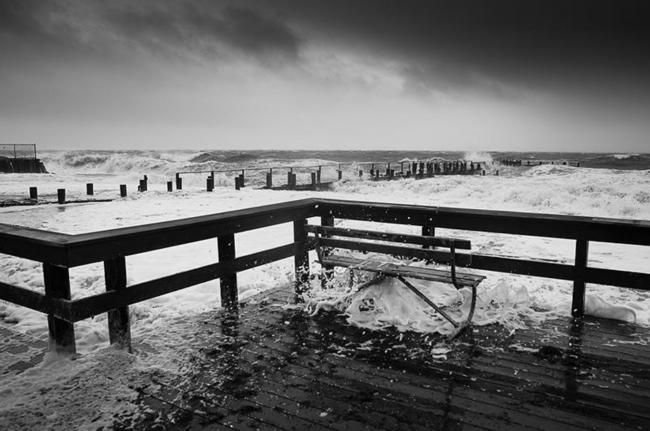



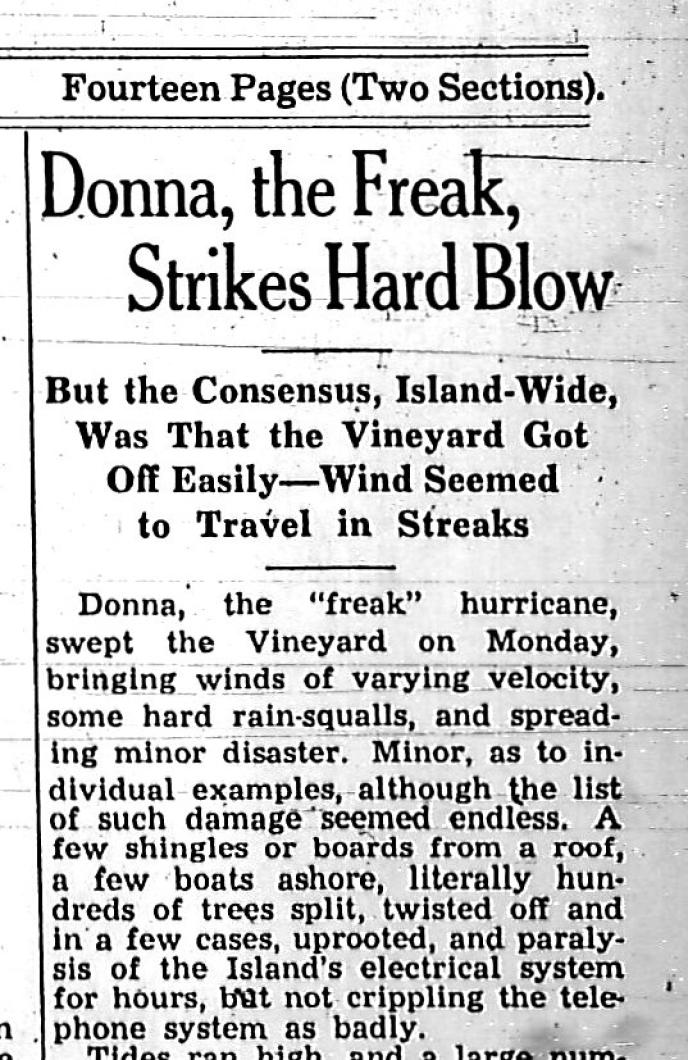

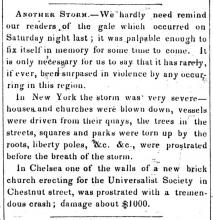
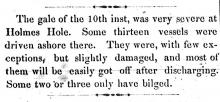

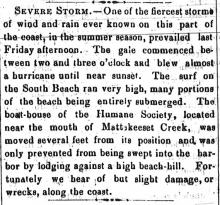
Comments